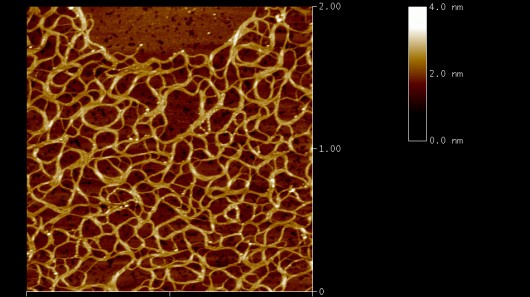
The super gel's 'nano ropes,' linked together to form a net-like structure (Photo: Radboud University Nijmegen)
Gelatins take on a semi-solid state when cool, and become a liquid when heated, right? Well, not always. Chemists from Radboud University Nijmegen, in The Netherlands, have created a “super gel” that behaves in the opposite manner – it’s liquid when cool, and stiffens when heated. What’s more, it reportedly absorbs water 100 times better than other gels. To make it, the researchers copied the protein structure of human cells.
A team led by Prof. Alan Rowan and Dr. Paul Kouwer made the gel using a synthetic polymer known as polyisocyanide. Its molecules twist together to form strong, stiff networks of what are referred to as “nano ropes.” Each cell in our bodies contains thousands of protein structures that are structurally very similar to these ropes.
“Not only is the structure of our material strikingly similar to the cell proteins, but the strength and sensitivity of the two materials are practically identical, even if you suddenly pull them hard,” said Kouwer.
The gel’s molecular structure is what’s responsible for its seemingly reversed temperature responses, and for its ability to suck up water. “A bucket” of water can be transformed into a gelatinous state, by adding less than a gram of the material. Additionally, the temperature at which the gel changes states can be manipulated – depending on what’s required, that can range from room temperature to body temperature.
Various uses for the gel are being considered, such as cosmetic applications, filtration for nanomaterials, and a medium for cell growth. It may also find use as a bacteria-blocking wound dressing that remains in place while at body temperature, but that turns to liquid when cooled, for easy removal.
A paper on the research was published today in the journal Nature.
Source: Radboud University Nijmegen
Copyright © gizmag 2003 - 2013 To subscribe or visit go to: http://www.gizmag.com